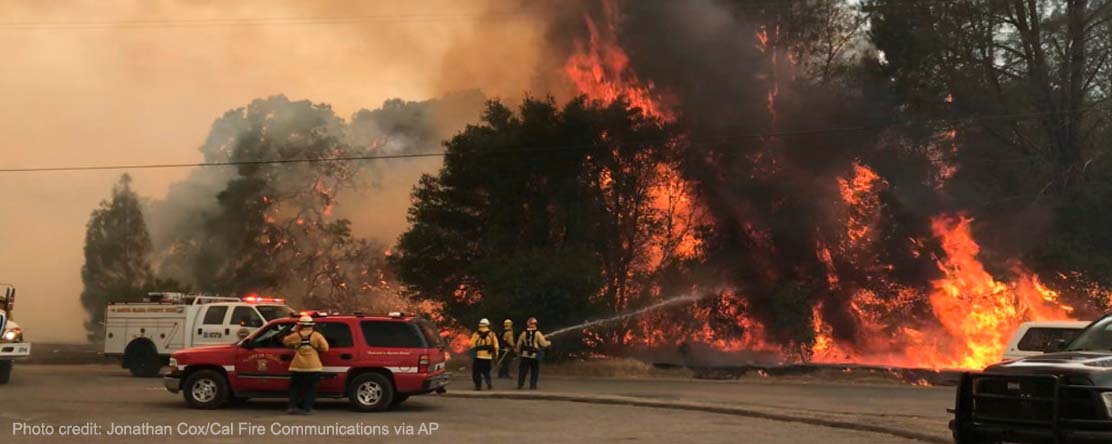
In the News
Preparing for the Health Impacts of a Fiery Future
-
Focus Areas
Capacity Building & Leadership, Environmental Health -
Issues
Asthma, Climate Change, Rural Health, Wildfires & Extreme Heat -
Programs
Center for Climate Change and Health

 The 2018 fire season has officially begun, and it’s likely to be a bad one. At this writing, over a dozen large wildfires are burning in the western U.S., including a blaze in Colorado that has torched more than 23,000 acres. Here in California, at least thirteen wildfires are burning across the state.
The 2018 fire season has officially begun, and it’s likely to be a bad one. At this writing, over a dozen large wildfires are burning in the western U.S., including a blaze in Colorado that has torched more than 23,000 acres. Here in California, at least thirteen wildfires are burning across the state.
Welcome to the new normal. On a warming planet, we are seeing more of the hot, dry conditions that have turned the American West into a tinderbox. Indeed, the very concept of “fire season” is a thing of the past: according to the U.S. Forest Service, climate change has made wildfire a year-round problem.
Wildfire poses well-known risks to life and property. It’s less well known that wildfire is also creating a public health crisis. But there are steps we can take to protect our health in a fiery future.
Consider this: last year’s wildfires in Northern California produced the highest levels of pollution ever recorded in the area. In just two days, those fires produced as much pollution as all the state’s cars do in a year.
Wildfire smoke is laden with particulate matter, which triggers asthma, worsens lung and heart disease, and is linked to premature births and low birth weight babies.
And, as fires incinerate everything in their path — including plastics, paints and pesticides — they release toxins into the environment. In Sonoma County last year, for example, melted plastic pipes may have contaminated drinking water with benzene.
The health impacts of wildfire travel long distances: smoke from last year’s Northern California wildfires was detected more than 500 miles away in Mexico. In 2002, smoke from fires in Quebec drifted down the U.S. East Coast, causing a nearly 50 percent increase in hospital admissions for respiratory disease.
Some people face greater health risks from fire. Pregnant women, children, and the elderly are especially vulnerable. For children, particulate matter can impact the development of their respiratory systems, leading to lifelong impacts from smoke exposure.
And — as with many health problems — low-income and marginalized communities suffer the worst impacts from inhaling wildfire smoke. That group includes undocumented immigrants, who often work outdoors and lack access to adequate health care. People with preexisting cardiovascular disease and asthma are particularly at risk, and low-income people of color have higher rates of those illnesses.
There are mental health impacts, too. Displaced residents and emergency responders often suffer anxiety, depression and PTSD in the wake of a devastating fire.
Given the huge — and growing — health impacts of wildfire smoke, what can we do to protect our communities?
Here are some actions we can take right now:
Identify high-risk populations. Protecting the vulnerable starts with knowing who they are. Research and mapping can identify “hot spots” where poverty and poor health put people at greater risk. Once vulnerable communities are flagged, health officials can target interventions, such as indoor-air filters, to help those at greatest risk.
Monitor wildfires—and their impact. Local governments can do a better job of monitoring rapid shifts in the direction and levels of wildfire smoke. New tools — such as low-cost, portable monitors — can help. Expanded air monitoring linked with real-time health surveillance could be used to quickly recognize and respond to impacts.
Improve communications capacity. Communities must have mechanisms in place to inform all residents about fire hazards and health risks, including those who speak languages other than English.
Provide shelter and care. Communities can establish “clean air shelters” with filtered air to give a respite from breathing smoke-laden air, and provide respirators (especially for young children and the elderly). It is also essential to quickly ramp up mental health services in fire-impacted communities.
Prevent future wildfires. There are many steps communities can take to reduce fire risk. For example, they can develop land use policies that reduce development in fire-prone areas, and enact building codes that make homes less flammable (and less toxic in the event of fire). Smart forestry management and healthier watersheds can reduce the fuel that ignites hotter, deadlier conflagrations. And, finally, we must step up the fight against climate change, so the “new normal” doesn’t get even worse.
Read the full op-ed in the San Bernardino Sun.
Originally published by The San Bernardino Sun
More Updates
Work With Us
You change the world. We do the rest. Explore fiscal sponsorship at PHI.
Support Us
Together, we can accelerate our response to public health’s most critical issues.
Find Employment
Begin your career at the Public Health Institute.



